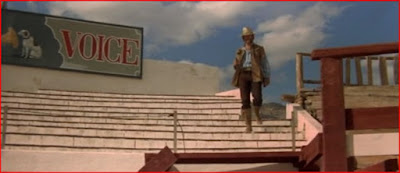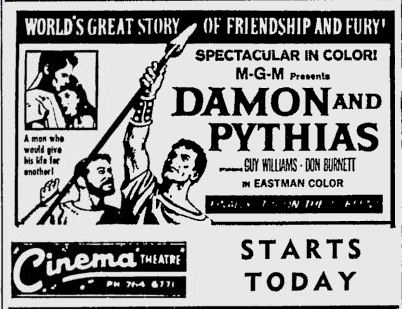Roy Lane: I'd like to see someone make me stop talking!
Showgirl: So would I!
Was Paul Fejos Hollywood's answer to Abel Gance or the Michael Bay of the 1920s? The Hungarian polymath, whose life (at least as told by himself) reads like a pulp adventure novel, has made a name for himself anew with the Criterion Collection's DVD release of his expressionistic, experimental 1928 part-talkie Lonesome. With Lonesome came two more Fejos features, but the silent Last Performance instantly threw his talent into question. One hoped for a prototype for Universal's horror cycle from the story of a stage magician (Conrad Veidt) using his illusion skills to frame a romantic rival for murder, but the picture betrayed Fejos's deep disinterest in narrative. It comes to life only when the director can play with double-exposures and dissolves or can find excuses to move his camera around the set. Whatever that film's box-office fate, Carl Laemmle Jr. remained enamored with Dr. Fejos, entrusted him with a big-budget all-talking adaptation of a landmark Broadway show, and gave him what he wanted most: a new toy. This was the "Broadway Crane," developed by Fejos and cinematographer Hal Mohr to allow the camera almost literally to take flight, gliding, swooping and diving across seemingly vast heights and distances. D.W. Griffith could have used something like it to film the Babylonian scenes of Intolerance, but Fejos and Mohr applied it to the story of a song-and-dance man desperate to get out of a lousy nightclub gig and break into vaudeville. To make room for the crane, the Paradise Club, named ironically in the play, becomes an Expressionist cathedral, more fit for the Phantom of the Opera than the gangsters and showgirls clamoring for attention here.
Fejos is always out for sensation, and the opening to Broadway is sensational. Universal built a detailed scale model of Times Square, that lit up for night scenes, for the crane (or a smaller version of it) to explore as a thunderous overture blasts out. At night, a giant strides through town, an amazing colossal Bacchus who pours a drink from a bottle and cackles insanely (though silently) as the opening credits appear.
Earlier this summer I was watching Universal's 1939 Green Hornet serial and wondering where the amazing cityscapes in the chapter recaps came from. Now I know, but now the question is: who's the uncredited behemoth having a blast below?
After the credits comes the now-typical Fejos montage with lateral dissolves and multiple exposures, and while his tricks may be familiar by now this one still dazzles, conveying the immensity and energy of the Great White Way for which the play and picture are named.
We get an early hint of the scope of the Paradise Club as its proprietor takes a little walkabout, but we also get some character development. Glenn Tryon, Fejos's male lead in Lonesome, plays Roy Lane, the hoofing headliner of the Paradise floor show who hopes for better things. Can you blame him? Every night he has to walk something like the length of a landing strip from the curtain to the edge of the stage before he can begin to sing. That has to get hard on the legs, especially when they expect you to dance, too. His first appearance on stage gives the crane its first real workout, and it is kind of awe-inspiring or, to use a synonym, awful. Everyone's "Overproduced!" alarms will go off, but to the extent that Broadway is an Expressionist film Fejos probably should get a pass.
Glenn Tryon's ambitions are laid bare, nearly, in Broadway.
Tryon and the Broadway crane get from there to here in one tracking shot.
Roy has a rival for the affections of his dance partner Billie (Merna Kennedy, Chaplin's leading lady from The Circus). The rival, Steve Crandell (Robert Ellis), wants to muscle in on the bootleg liquor racket at the Paradise. To do that, he has to eliminate Scar Edwards and throw the body, with the help of a henchman (archetypal Hollywood drunk Arthur Housman at his most stone-cold sober, ever), into a dump truck. He also has to make sure that Billie, who saw him and Housman escort a "drunk" out of the club, keeps quiet about it, especially since another showgirl, the dangerously sullen Pearl (Evelyn Brent of Sternberg's Underworld) is Scar's girlfriend. Meanwhile, a police detective (Thomas E. Jackson) finds the body and starts hanging out at the Paradise to see who'll crack or who'll squawk. Jackson played the same part on stage and brings a certain "take them...for...a...ride" authenticity to the picture.
Arthur Housman knows better, for once, not to get high on his own supply.
He knows where the bodies are buried, too.
Broadway seems like the Warner Bros. picture the studio never made, an ultimate mashup of the Warners gangster formula and the Busby Berkeley backstager. Fejos's approach can only leave you wondering what Warners would have done with this story, or regretting that they didn't get a chance. Broadway fails as a backstager and a musical because the director appears to have no interest in the musical numbers. He has this incredible device with which he could have done incredible things with the numbers like filming amid the showgirls, but whenever the girls arrive en masse, that's usually his cue to rear back to the ceiling or cut away to the detective's cat-and-mouse game with the gangsters. His crane stunts eventually become repetitive; he even repeats some numbers and films Tryon's entrances the exact same way as before. He's more interested, as he was in Last Performance, in backstage activity. Some of the best shots are of the company proceeding through several layers of curtains as they take the stage, with the camera just ahead of them and parting the curtains for them, or a group of showgirls dashing from their dressing room to get into position. As ever, movement, whether of the camera or the people it films, is an end unto itself for Fejos, but he does achieve a payoff moment of poetry with his monster crane and monster set. It comes the morning after the show and a wild party that followed. The crane starts at floor level, just inside the entrance, as scrubwomen clean the floors, and rises to its full height before panning across the club's towering balconies before descending to the stage, where janitors are sweeping up.
I'm as much a sucker for pure spectacle as anyone, but I doubt anyone can watch Broadway without questioning whether all the apparently monstrous expense was necessary, or appropriate. You'll wish that Fejos had cared more about acting and gotten either better performers or better work from the obnoxious Tryon, the glowering Brent, and the simpering Kennedy -- who, ironically enough, would later be Mrs. Busby Berkeley. As the evidence comes in, it looks increasingly like the humane sentiment of Lonesome was a happy accident or Fejos's random choice of scenario. The man had talent and even some pictorial genius, but whether through Hollywood's fault or his own, he had a hard time finding proper vehicles for his peculiar genius. After being denied the directing gig for All Quiet on the Western Front he was done with Universal and on to new adventures and several more filmmaking careers. He left behind plenty worth seeing, including plenty of Broadway, but that film is a supreme case of the whole being less than the sum of its parts. If you're a specific fan of cinematic folly and overreaching ambition, Broadway is a fascinating trainwreck that's strongly recommended.
























































